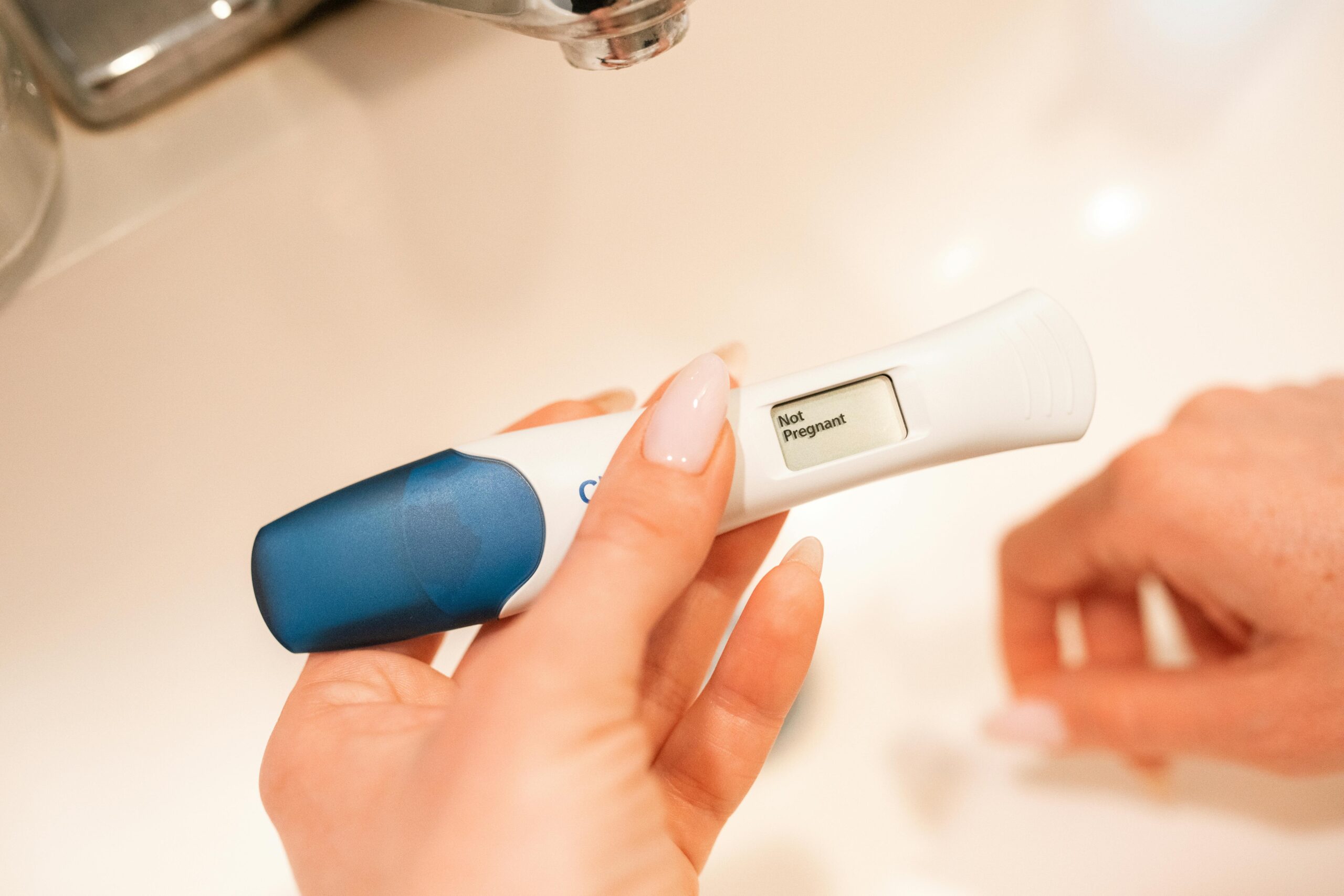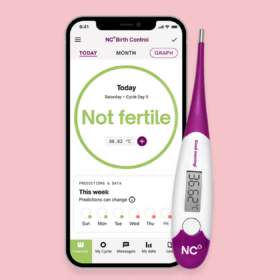
A complete guide to non hormonal contraception
Disclaimer: This article is sponsored by Natural Cycles, but just like all of our other content, this is a completely honest breakdown. See our Content Policy for more details.
In this article
What's the lowdown?
Non hormonal contraception comes in various forms, contains no synthetic hormones and has a range of clinical effectiveness.
The most recent developments in non hormonal contraception and birth control include digital contraception like the Natural Cycles app, and the Ballerine IUB.
More often than not, non hormonal contraception requires the user to be responsible for making sure it is being used effectively, whether that’s through fertility tracking, or just remembering to use a barrier method!
The most effective form of non hormonal contraception is the copper coil (IUD)
A huge attraction for many people considering non hormonal contraception is the minimal-to-no risk of the side effects that are associated with hormonal contraception. This doesn’t mean that hormonal contraception is worse than non hormonal methods – hormonal methods have non-contraceptive benefits too – it’s simply down to personal preference! Whatever contraceptive you choose, make sure it’s the right one for you.
What is non hormonal birth control?
Non hormonal contraception simply means a method of birth control that contains no synthetic hormones that work to prevent pregnancy. Non hormonal contraception comes in various forms; be that internal like the copper IUD, external barrier methods like condoms or a ‘natural’ way of calculating when you are fertile and avoiding unprotected sex at this time.
There’s been some interesting developments in ‘natural’ non hormonal birth control methods in recent years. ‘Digital contraception’ like the Natural Cycles app uses smart tech and algorithms to create a method of contraception that’s been shown to be 93% effective with typical use. Essentially, an updated version of the historic symptothermal and cycle tracking methods, known as Fertility Awareness Based Methods (FABM).
But it’s not all cycle tracking and working out your fertile days! While tracking methods can make you feel more in tune with your natural menstrual cycle and hormone fluctuations, all that admin isn’t for everyone. The copper coil (IUD) is a non-hormonal long acting reversible contraceptive (LARC), a great option for those who just want to ‘set it and forget it’ as once fitted it can last for years. And of course, there’s always the trusty condom – which unlike the rest of these methods, helps to protect you from STIs.
Keep reading for a full breakdown of the many forms of non hormonal contraception. To work out which method may work best for you, try our contraception recommender, or book an appointment with one of our lovely women’s health GPs for advice.
Intrauterine devices
An intrauterine device (IUD) is a small device placed inside the womb to prevent pregnancy. The hormonal alternative to the IUD is the intrauterine system (IUS), which releases small amounts of the hormone progestogen to prevent pregnancy. But how does the IUD work without hormones?
The copper coil (IUD)
The copper coil (IUD) is a small T-shaped device made of plastic and copper. It lasts for 5-10 years. It works to prevent pregnancy by releasing tiny amounts of copper into the womb which affects the motility of any sperm, and preventing the fertilisation of an egg. Because of this, the copper coil is also a form of emergency contraception which can be fitted after unprotected sex. Check out our emergency contraception guide for more on this.
This non hormonal contraception method could work for you if you don’t want to have to remember to take a contraceptive every day or every time you have sex. Sounding too good to be true? Something to consider with the copper coil is its potential impact on your bleeds – over two thirds of reviewers on The Lowdown reported having heavier periods. For more information on the copper coil, check out our complete guide.
To have a copper coil fitted, you need to make an appointment with your GP or local sexual health clinic.
Other types of non hormonal IUDs
The Ballerine IUB (intrauterine ball) is a newer non hormonal contraceptive that works in exactly the same way as the copper coil to prevent pregnancy. The main differences being it is smaller, and made of 17 copper balls on a string that sit in a spherical shape. Because of the type of plastic used and the IUB’s rounded shape, it contracts and expands more easily with the womb muscles.
This little non hormonal intrauterine device has been on everyone’s lips since it launched in Europe in 2014. We consistently get asked when it will be available on the NHS in the UK, and the unfortunate answer is that we don’t yet know for sure! Trust us – we will let you know when it is! For now, have a look at our guide to the IUB for more information.
In the US, the Miudella is the new kid on the block which uses a lower amount of copper compared to its American sister the Paragard and has a novel flexible frame.
Digital contraception
Ever heard of the term ‘digital contraception’? It’s an exciting new development in non-hormonal birth control and fertility awareness methods (more on those later). Digital contraceptives are essentially fertility tracking methods that neatly store your inputted data in an app, with clever algorithms that help you work out when you are fertile.
Natural Cycles
The Natural Cycles app was the first FDA cleared (US) and CE marked (Europe) digital contraceptive. Essentially, these accreditations mean it’s the real deal. Derived from the symptothermal method that’s been used for years as birth control, Natural Cycles is powered by an algorithm that analyses your daily temperature to work out your ‘fertile’ and ‘non fertile’ days, aka, red and green days. Natural Cycles has been shown to be as effective as the pill with typical use (93%).
Using a basal thermometer, you measure your temperature first thing in the morning when you wake up. You then input your temperature into the app along with recording when you have a period. You also have the option to track any other menstrual cycle updates (like how heavy your flow is), mood changes, vaginal discharge, sex drive and physical symptoms. The more temperature and cycle data you log, the more accurate the data will be!
This allows the algorithm to get to know your natural cycle and predict your fertile window around when you ovulate. If you forget to measure, the app doesn’t get any less effective, you might just get more red days. For those with conditions that affect temperature, or those with irregular cycles, the app may not be able to predict ovulation and therefore may also give more red days. Remember, when you have ‘red’ fertile days, abstain from sex or use other contraception such as condoms. If relying on condoms on fertile days make sure you use these consistently and correctly. With typical use condoms have been shown to be only around 85% effective.
You can now use Natural Cycles alongside the Oura Ring, a smart ring that analyses and sends temperature trend data straight from the ring to your Natural Cycles app. This means you can track your temperature automatically whilst sleeping, rather than manually taking your temperature when you wake up. The ring is quite pricey from what we can tell, but it’s a cool new development in digital contraception and worth investing if you don’t want to take your temperature every morning! Find out more about how the Oura Ring compatibility works in our guide to Natural Cycles.
If you’re curious about this non hormonal method but aren’t sure about making the switch just yet, some people choose to use Natural Cycles alongside having a copper coil (IUD). This ensures you will be protected from pregnancy even on ‘red’ fertile days, whilst getting to know more about your body’s hormone fluctuations, PMS symptoms and menstrual cycle. So if you’re thinking about making the switch to digital contraception and fertility tracking, ‘doubling up’ with the copper coil could be an option.
Check out our complete guide to Natural Cycles for more information, including a breakdown of that clinical effectiveness number (yes, it really has been shown to be as effective as the pill), how to use it, and the pros and cons of this digital contraceptive. If you’re already intrigued, head to this link for 15% off a Natural Cycles subscription and a free thermometer using the code LOWDOWN15!*
*FYI – this is an affiliate link, which means The Lowdown will earn a commission on any purchases made.
Fertility awareness methods
Fertility awareness based methods (FABM), also known as natural family planning, means learning how to identify your own fertile window through indicators such as cycle length, cervical fluid or discharge, or daily temperature. It can also refer to natural contraception methods like breastfeeding – yep, our bodies are amazing like that. When using a fertility awareness based method, it’s recommended you use other contraception such as condoms or abstain from sex in your fertile window.
Breastfeeding (LAM)
By following specific conditions, breastfeeding can actually be used as a non hormonal method of contraception, also known as the Lactational Amenorrhea Method (LAM). And when done right, it’s 98% effective. If you want to use breastfeeding as contraception, check out our guide with more information on the three conditions required:
- Your baby is less than six months old
- You are exclusively (or almost exclusively) breastfeeding day and night
- Your periods have not returned
Symptothermal Method
The symptothermal method is when you observe and chart your menstrual cycle, cervical fluid,
waking temperature and other biological signs to identify the fertile window in your cycle. You can do this using a good ol’ paper and pen, keeping track of this information using a calendar or a log in your phone. We would recommend, as one Lowdown reviewer mentions, learning more about this method from a Fertility UK instructor to ensure you are using it as effectively as possible.
While this method can be super empowering, something to consider is whether you know you will be able to reliably track your waking temperature and your menstrual cycle – so this may not be the best method for someone doing shift work, who has an irregular schedule or even a condition that can affect your ability to carry out daily tasks, such as depression or attention deficit hyperactivity disorder (ADHD). Speak to a healthcare professional for further advice.
Barrier methods
What is a barrier method? These non hormonal contraceptives pretty much do exactly what they say on the tin: creating a thin barrier between the genitals so that sperm cannot enter the womb to fertilise an egg.
Male condoms
The most well known barrier method out there, the male condom is a single-use barrier method of non hormonal contraception. Made of thin latex or polyurethane, a condom covers the penis to catch any sperm released during ejaculation. The biggest advantage of using condoms is that they also help protect you from STIs. Check out our condom 101 for a full guide.
Fun fact: you can also create a makeshift dental dam from a male condom for use during oral sex. A dental dam creates a barrier over the vulva or anus to help prevent the spread of STIs. To do this, use a new condom fresh from the packet, cut off the tip, base and down one side so it opens up into one larger piece of stretchy material, and voila! Never cut or split condoms otherwise, as you will not be protected from pregnancy.
Female condoms
A lesser known and lesser used method of non hormonal contraception is the female condom, sometimes called a ‘femidom’. Another single-use barrier method made of thin plastic, the female condom is a tube-like pouch that is inserted into the vagina that can also protect against STIs. With typical use, the female condom is around 79% effective, whereas the male condom is around 85% effective.
The cap or diaphragm
The cap or diaphragm is a reusable non hormonal contraceptive that is less popular now than it was around 20 years ago. It’s a circular dome-shape, made of soft silicone, and is inserted into the vagina similarly to a menstrual cup. For the cap or diaphragm to be effective, it must be used with spermicide, and you need to check that it is covering your cervix. Your healthcare provider will be able to show you how to effectively use this method.
Permanent contraception
And finally, there’s permanent contraception. While non hormonal, these methods do require a surgical procedure to take place. Because of this, they are not routinely offered to younger people.
Female sterilisation
Female sterilisation, aka getting your tubes tied, is a permanent method of non hormonal contraception that involves a surgical procedure. In order to prevent pregnancy, the fallopian tubes are blocked or sealed to stop eggs reaching the sperm and becoming fertilised. This method is not routinely offered to younger people, as it’s a non-reversible surgical procedure that will prevent you from having any children in future. You’re more likely to be accepted for female sterilisation if you’re over 30, or have already had children.
Vasectomy
A vasectomy (also known as male sterilisation) is a permanent surgical procedure. It can technically be reversed in some cases, but not easily – and also, what a faff. The tubes that carry a man’s sperm are cut or sealed, preventing pregnancy by stopping any sperm making its way into semen. So when ejaculation occurs, releasing semen into the vagina, there’s no sperm to fertilise an egg.
What’s the best non hormonal contraception?
There is no best non hormonal contraception. This is an individual choice based on your feelings about the method and any side effects you experience. You can use Lowdown reviews and our comparison tool to search for how other people have found each method.
Non hormonal oral contraceptives
There is no non hormonal contraceptive pill available in the UK. In India, a non hormonal pill called Saheli or Chhaya is available which is taken once a week and has a typical effectiveness rate of between 90-98%. It works by affecting the lining of the womb so a fertilised egg can’t implant and grow into a pregnancy, and it does not contain any hormones, so users still ovulate each month.
However, Saheli or Chhaya are not available in the UK. There is research ongoing into a drug called misoprostol in the UK, which is already used as an abortion pill, but could be used as a non hormonal contraceptive option in the future.
What’s the future of non-hormonal contraception?
Hopefully we won’t have to wait too much longer for newer contraceptives to be rolled out across the UK, but what else should we look out for? Natural Cycles have received FDA clearance after a proof-of-concept study to integrate ‘wearables’ into the app. Essentially, a little wearable thermometer that will continuously monitor your temperature and other body signals to help protect you from pregnancy by accurately tracking when you ovulate from your temperature curve. This is great news for people who may have been previously put off the method due to how meticulous you need to be with manual tracking, sign up to their waitlist for further updates!
You may or may not have also heard of Coso, which won the James Dyson Award in 2021 for its clever design. It’s a reversible male contraceptive that essentially heats up testicles using ultrasound waves through water. Simply turn it on, wait for it to heat to the right temperature, and sit for a few minutes with your testicles dipped into it. Sounds… relaxing? The design is based on research that found ultrasound contraception has been successful on animals, but it’s not been tested on humans, so don’t hold your breath just yet.
Smart RISUG is another reversible non hormonal male contraceptive that research has shown to be a promising alternative. Similar to a vasectomy, RISUG works by injecting non-hormonal chemicals to partially block the sperm duct and deactivate sperm before they leave the body.
If you think one of the many methods of non hormonal contraception that are currently available may work for you, you can always book an appointment with one of our lovely team of women’s health doctors for further support and advice. Or, if you’d like to directly compare either of these methods, try our contraception comparison tool to see the data side by side, including side effects, benefits and effectiveness.
Our medical review process
This article has been medically reviewed for factual and up to date information by a Lowdown doctor.


